

Written by He Yan
Editor: Wang Sizhen
Parkinson’s Disease (Parkinson’s Disease, PD) is a chronic progressive neurodegenerative disease, second only to Alzheimer’s disease, with its incidence increasing with the aging population【1】. PD primarily affects dopaminergic neurons in the substantia nigra pars compacta (SNc), where α-synuclein (α-Synuclein, α-Syn) accumulates, leading to neuronal death. The SNc mainly projects to the dorsolateral striatum (DLS), which regulates procedural behavior (corresponding to the tail of the caudate nucleus in humans)【2, 3】, resulting in the early onset of procedural behavior disorders in patients. Current research on PD mainly focuses on motor disorders, with little known about non-motor disorders such as cognitive function.
Adenosine A2A receptor (Adenosine 2A receptor, A2AR is a member of the adenosine receptor family, specifically expressed in the indirect pathway neurons of the striatum【4】.A2AR can regulate dopamine D2 receptors (D2R) and NMDA glutamate receptors (NMDAR) through antagonistic interactions, and it also regulates metabotropic glutamate receptors 5 (mGluR5) and cannabinoid 1 receptors (CB1R) in a synergistic manner, playing an important “integrative” role in striatum-dependent behavior regulation【5】. Our previous research indicated that optogenetic activation of DLS A2AR inhibited habitual behavior in mice, while conditional knockdown of A2AR in the DLS promoted habitual behavior【4】. Furthermore, studies have shown that the A2AR-specific antagonist KW6002 not only improves motor disorders in PD patients but also has unique cognitive-enhancing and neuroprotective effects, and it has passed FDA phase III clinical trials【6】.
On August 3, 2021, the research team led by Chen Jiangfan from Wenzhou Medical University published a paper titled “α-Synuclein selectively impairs motor sequence learning and value sensitivity: Reversal by the adenosine A2A receptor antagonists” in Cerebral Cortex, proposing that sequence learning impairments are primarily regulated by the lateral pathway of the substantia nigra pars compacta – dorsolateral striatum circuit, while goal-directed behavior deficits are mainly influenced by the dorsomedial striatum. The research team’s previous work indicated that A2A receptors play an important inhibitory role in habits (a form of procedural learning). In this study, pharmacological blockade of A2A receptors reversed sequence learning impairments induced by α-Syn aggregates, demonstrating that AA2A receptor antagonists could serve as potential drug targets for treating cognitive impairments in Parkinson’s patients.
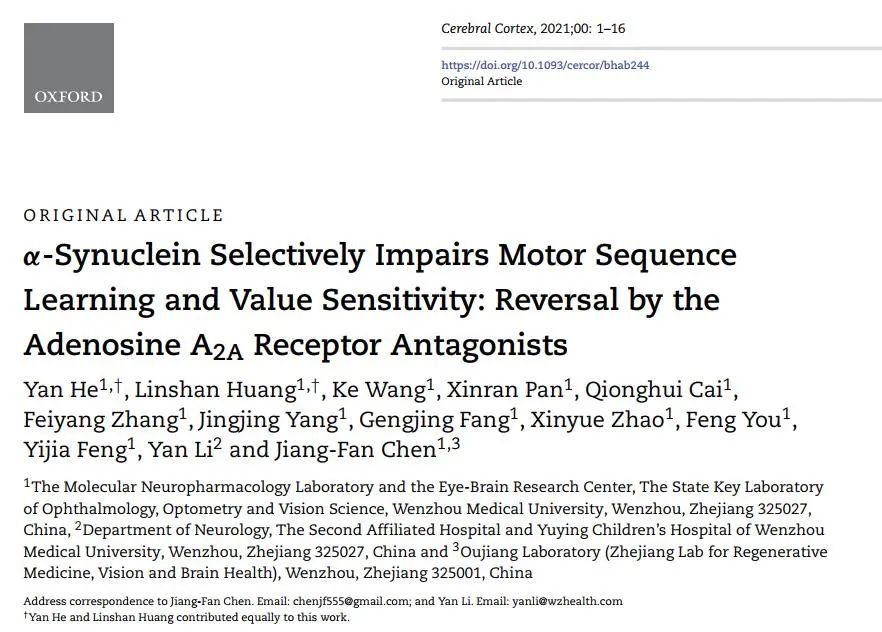
In recent years, non-motor symptoms of PD, such as cognitive impairment, sleep disorders, and depression, have received increasing attention【7】. The emergence of these non-motor symptoms can even precede motor symptoms, significantly reducing the quality of life for patients. Research by Bove J et al. has shown that widely used neurotoxins such as MPTP and 6-OHDA have significant effects on motor function in PD models, leading to confounding effects on cognitive behavioral assessments【8】. Transgenic animals, such as A53T gene mutant mice, exhibit widespread accumulation of α-Syn in the brain【9】, making it difficult to simulate the progressive pathological process of PD patients and study cognitive behavioral dysfunctions at different stages of PD, which has certain limitations. Therefore, this study established a PD mouse model through regional injection of α-Syn aggregates in the brain, overcoming the limitations of research methods and animal models, providing a good foundation for further research on early PD-related cognitive behavioral disorders (Figure 1, see later).

Figure 5: Golgi staining results and reconstructed two-dimensional distribution map of neurons: α-Syn can damage the morphological structure and integrity of medium spiny neurons.
(He Y, et al., Cereb Cortex 2021; 3: bhab244)
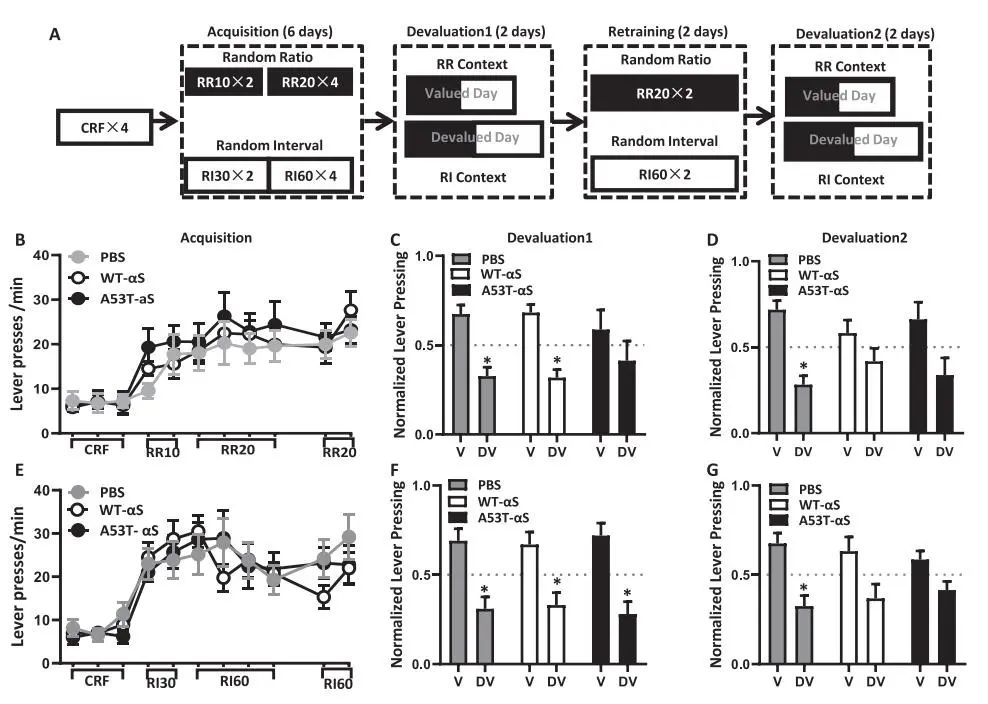
Figure 2: Abnormal aggregation of α-Syn in the DMS selectively damages goal-directed behavior.
(He Y, et al., Cereb Cortex 2021; 3: bhab244)
Procedural behavior disorders are an important pathogenic mechanism for many clinical manifestations of PD. Procedural learning refers to the process of acquiring new knowledge through the repeated execution of motor tasks, aided by skeletal muscles and corresponding neural reflexes【10】. Based on the order of presentation of learning content, it can be divided into sequence learning and probabilistic learning【11, 12】. In this study, the authors established a PD mouse model by injecting recombinant wild-type and A53T mutant α-Syn aggregates into specific brain regions, and the following results were obtained through sequence learning and goal-directed behavioral paradigms: 1) Contrary to the traditional view of early habitual learning deficits in PD, injection of α-Syn aggregates into the dorsomedial striatum (DMS) selectively impairs goal-directed behavior (Figure 2); 2) Injection of α-Syn aggregates into the dorsolateral striatum (DLS) and SNc selectively impairs the accuracy of the first step in sequence learning, thereby affecting the initial stage of learning, and α-Syn aggregates have different effects on sequence learning and habitual learning in the DLS (Figure 3); 3) The specific A2A receptor antagonist KW6002 selectively enhances the initiation and transition phases of sequence learning, improving motor activity (Figure 4).
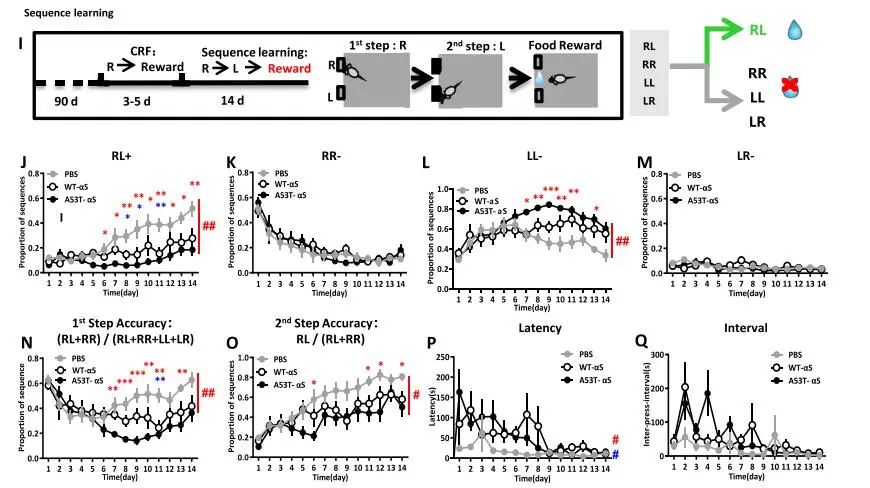
Figure 3: Modeling results of sequence learning in the dorsolateral striatum (DLS).
(He Y, et al., Cereb Cortex 2021; 3: bhab244)
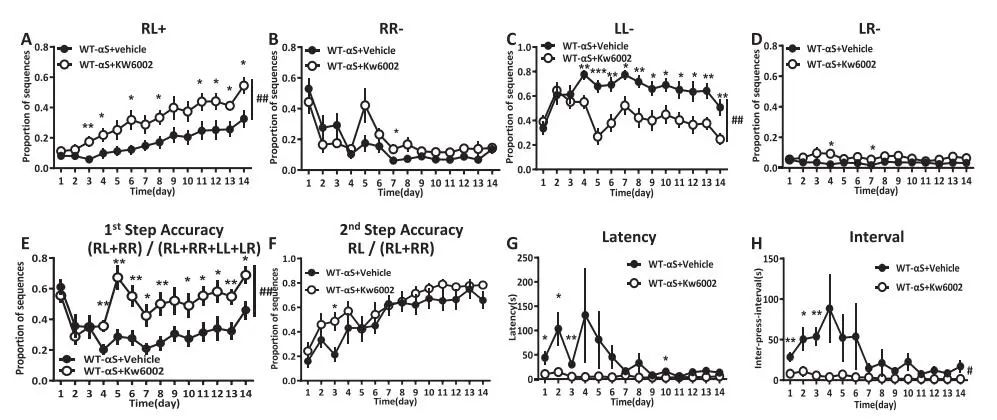
Figure 4: The regulatory effect of KW6002 on sequence learning in WT α-Syn mice model.
(He Y, et al., Cereb Cortex 2021; 3: bhab244)
Additionally, in PD mouse models induced by 6-OHDA or MPTP, the number of dendritic spines significantly decreases; in α-Syn-mediated PD mouse models, the dendritic density of TH-positive neurons is also reduced; and in MitoPark-mediated PD mouse models, there is a reduction in the number of dendritic branches and dendritic length. This experiment assessed the dendritic complexity of PD mice induced by α-Syn, and the results showed a decrease in dendritic density in neurons in the DLS/DMS regions (Figure 5, see previous).
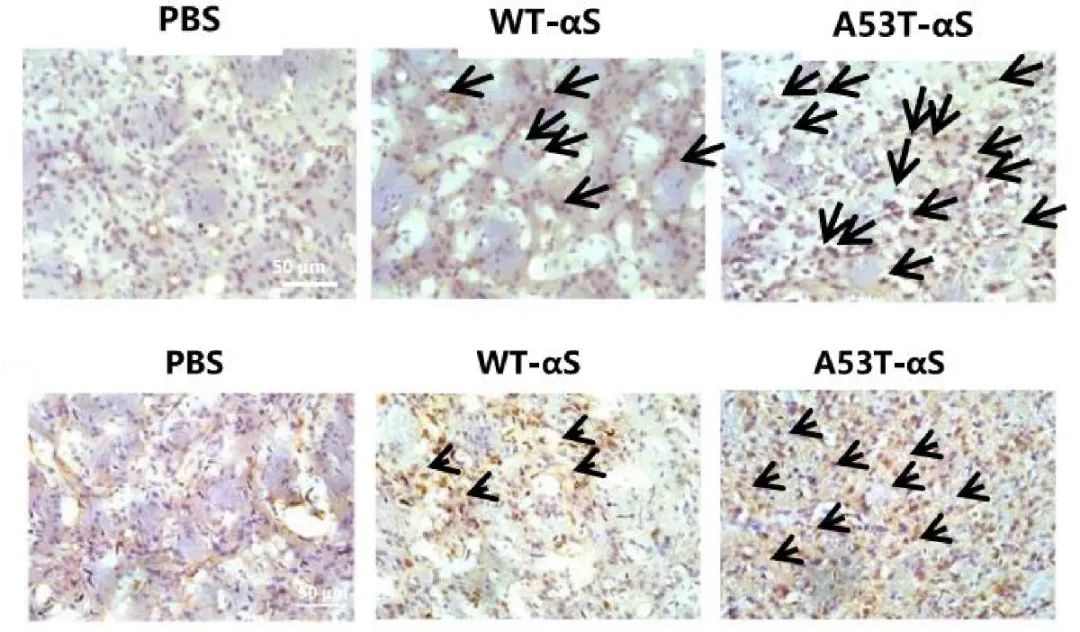
Figure 1: Phosphorylated α-Syn aggregation in the DMS (top) and DLS (bottom) reduces neuronal density.
(He Y, et al., Cereb Cortex 2021; 3: bhab244)
Conclusion and Discussion: Overall, this study suggests that the successful establishment of a PD mouse model with specific procedural learning impairments through the injection of recombinant α-syn aggregates in the brain occurs without significant spontaneous motor damage. Based on this PD model, the study determined that sequence learning is primarily regulated by the lateral pathway of the substantia nigra pars compacta – dorsolateral striatum circuit rather than the medial pathway – dorsomedial striatum circuit, significantly affecting the initiation phase of learning. Furthermore, this study also suggests that the A2A receptor-specific antagonist KW6002 has a specific protective effect on procedural learning impairments while improving motor disorders in PD patients, indicating that the A2A receptor may be an important drug target for treating cognitive dysfunction in Parkinson’s disease, with significant clinical value.
Of course, this study still has questions to be addressed, such as the mechanisms by which A2A receptors improve sequence learning impairments, which require further research. Factors such as attention, motivation, and memory cannot be ignored in the cognitive learning process, and how to clarify their regulatory roles at different stages of sequence learning also needs further exploration.
In summary, this research deepens our understanding of the mechanisms underlying cognitive impairments in Parkinson’s disease and seeks a more effective therapeutic approach to improve the quality of life for Parkinson’s patients.
Original link: https://doi.org/10.1093/cercor/bhab244

First author: He Yan (second row left 5), first author: Huang Linshan (first row left 5), Corresponding author: Li Yan (second row left 6), Corresponding author: Chen Jiangfan (first row right 1)
(Image source: Chen Jiangfan Laboratory)
Selected previous articles【1】Int J Mol Sci: Frontline Review Interpretation: Pathophysiological Responses and Roles of Astrocytes in Traumatic Brain Injury
【2】Cereb Cortex | Wang Lang’s research group reveals that astrocytes have experience-dependent homeostatic plasticity
【3】Nature: New Discovery! Oxytocin Neurons Induce Social Transmission of Maternal Behavior
【4】Genome Biol: Ding Junjun’s team systematically maps the three-dimensional structure of chromatin during phase separation dissolution and reconstruction
【5】Brain: New Method! Plasma Astrocyte Proliferation GFAP as a Potential Biomarker for Alzheimer’s Disease Detection
【6】Autophagy: Zhang Zhidong’s team reveals a new mechanism of STING1-induced autophagy regulation of RNA virus infection
【7】Nature: Astrocyte-derived IL-3 regulates microglial function, alleviating AD pathological changes and cognitive impairments
【8】JCI: Gao Tianming’s research group reveals opposing neural circuits in the prefrontal cortex regulating anxiety and fear
【9】eLife: Single-cell sequencing and neural circuit analysis jointly reveal the molecular genetic coding mechanisms that initiate attack/defense instinct behaviors in the brain
【10】Nature: Cutting-edge! GluDs transmit different presynaptic signals to different postsynaptic receptor responses

References (scroll up and down to view)
【1】Broen, M. P., Narayen, N. E., Kuijf, M. L., Dissanayaka, N. N. & Leentjens, A. F. Prevalence of anxiety in Parkinson’s disease: A systematic review and meta-analysis. Movement disorders: official journal of the Movement Disorder Society 31, 1125-1133, doi:10.1002/mds.26643 (2016).
【2】Tricomi, E., Balleine, B. W. & O’Doherty, J. P. A specific role for posterior dorsolateral striatum in human habit learning. The European journal of neuroscience 29, 2225-2232, doi:10.1111/j.1460-9568.2009.06796.x (2009).
【3】Gasbarri, A., Pompili, A., Packard, M. G. & Tomaz, C. Habit learning and memory in mammals: behavioral and neural characteristics. Neurobiology of learning and memory 114, 198-208, doi:10.1016/j.nlm.2014.06.010 (2014).
【4】Li, Y. et al. Optogenetic Activation of Adenosine A2A Receptor Signaling in the Dorsomedial Striatopallidal Neurons Suppresses Goal-Directed Behavior. Neuropsychopharmacology: official publication of the American College of Neuropsychopharmacology 41, 1003-1013, doi:10.1038/npp.2015.227 (2016).
【5】Chen, J. F. Adenosine receptor control of cognition in normal and disease. International review of neurobiology 119, 257-307, doi:10.1016/b978-0-12-801022-8.00012-x (2014).
【6】Chen, J. F. & Cunha, R. A. The belated US FDA approval of the adenosine A(2A) receptor antagonist istradefylline for treatment of Parkinson’s disease. Purinergic signalling 16, 167-174, doi:10.1007/s11302-020-09694-2 (2020).
【7】Rodriguez-Oroz, M. C. et al. Initial clinical manifestations of Parkinson’s disease: features and pathophysiological mechanisms. The Lancet. Neurology 8, 1128-1139, doi:10.1016/s1474-4422(09)70293-5 (2009).
【8】Bové, J. & Perier, C. Neurotoxin-based models of Parkinson’s disease. Neuroscience 211, 51-76, doi:10.1016/j.neuroscience.2011.10.057 (2012).
【9】Sacino, A. N. et al. Amyloidogenic α-synuclein seeds do not invariably induce rapid, widespread pathology in mice. Acta neuropathologica 127, 645-665, doi:10.1007/s00401-014-1268-0 (2014).
【10】Yin, H. H. The sensorimotor striatum is necessary for serial order learning. The Journal of neuroscience: the official journal of the Society for Neuroscience 30, 14719-14723, doi:10.1523/jneurosci.3989-10.2010 (2010).
【11】Thiessen, E. D. What’s statistical about learning? Insights from modelling statistical learning as a set of memory processes. Philosophical transactions of the Royal Society of London. Series B, Biological sciences 372, doi:10.1098/rstb.2016.0056 (2017).
【12】O’Doherty, J. P., Cockburn, J. & Pauli, W. M. Learning, Reward, and Decision Making. Annual review of psychology 68, 73-100, doi:10.1146/annurev-psych-010416-044216 (2017).
Typesetting︱Wang Sizhen
This article is complete
